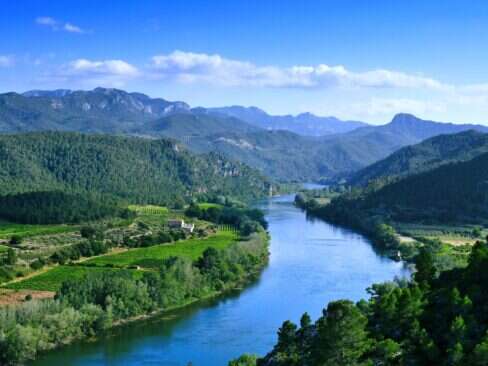With a long, culturally rich history of horsemanship, Spain is one of the most popular destinations for horse riding in Europe. With over 40 Certified Equestrian Routes throughout the country, a range of terrains, and sure-footed Spanish horses to ride, there is a horse riding adventure here for all levels of ability. Whether it’s cantering along the coast or pony trekking through a historic mountain range, in this curated collection of Spanish regions you are sure to find some of the best locations for horse riding in Spain.
Andalucía
The southernmost region of Spain, Andalucía is well known for producing high-quality wines and olive oil and for being home to one of the country’s most popular coastlines for tourists, the Costa del Sol. Horses have always been important to the history and culture of Andalucía, with the region even having its own distinct breed — the Andalusían, or Pure Spanish Horse — which has been formally recognized since the 15th century.

The Horse Fair in Jerez / ©Shutterstock
Andalusía is not only a historically and culturally important region either; it has the most varied terrain and vegetation in Spain, including alpine mountain ranges and subtropical plains, making it a fantastic destination for horse riding. There are many different horse riding experiences to be found here, including treks through Europe’s only desert, Tabernas (in the province of Almería); trails to follow across the Andalusían steppes and the Sierra Nevada mountain range; dressage lessons in the region’s capital, Sevilla; or visits to the internationally renowned Horse Fair in Jerez.
Catalonia
Perhaps best known for the city and province of Barcelona, the region of Catalonia lies at the other end of Spain, in the country’s northeastern corner. Bordered by the Mediterranean Sea to the east, Catalonia enjoys a truly Mediterranean climate with hot, dry summers and mild, rainy winters, offering opportunities for horseback adventures all year round. Barcelona, for example, has ample opportunities for hacks and riding lessons and is easily accessible thanks to the city’s Barcelona–El Prat airport.

Garrotxa Volcanic National Park / ©Shutterstock
For wilder horse riding adventures, opt for exploring the Pyrenees Mountains, which divide Spain from France and reach over 11,000 ft. More experienced riders can enjoy rides along the mountain peaks, and there are also treks that include journeying across mountain terrain and stretches of coastline with the backdrop of the Mediterranean Sea. If this wasn’t enough, Catalonia is also home to the stunning Garrotxa Volcanic National Park; take a horse riding tour of this incredible landscape, which features around 40 dormant volcanoes.
Canary Islands
Lying northwest of the African mainland in the Atlantic Ocean, the Canary Islands are an archipelago comprising several islands including Gran Canara, Fuerteventura, Tenerife, and Lanzarote. Many of the islands have sandy beaches set against the backdrop of mountain ranges; thanks to their location, the Canaries enjoy warm, subtropical climates that have only minor fluctuations depending on the time of year.

Riding in the Canaries / ©Shutterstock
With the proximity to northern Africa, horses in the Canary Islands tend to be a mixture of Arab and Spanish breeds that are sure-footed on the volcanic terrain, and comfortable in the climate. All the islands offer chances for horse riding but Tenerife, in particular, stands out — the island is home to Spain’s highest peak, the volcanic Mount Tiede, and the surrounding Tiede National Park. What better way is there to discover this natural wonder than trotting along the mountain trails on horseback?
[See also: The Best Road Trips in Spain]
Balearic Islands
Made up of two groups of islands including Majorca, Minorca, and Ibiza, the Balearic Islands are an archipelago in the western Mediterranean Sea near the Spanish mainland. The Balearics are also one of the most popular destinations in Spain, which is easy to understand when you consider the lush natural landscapes, azure waters, and warm, dry climates that these islands are famous for.

Riding at sunset / ©Shutterstock
Though the Balearics are best known as beach holiday destinations, they are also great for those interested in horse riding. Whether it’s cantering along the sandy beaches or watching the sunset over the horizon from your saddle, there’s a horse riding experience for everyone here – especially on the island of Minorca. This small island has one of Spain’s most beautiful examples of a Green Way, the Cami de Cavallas Nature Path: 114 miles of ancient pathway along cliffs, through forests, and amidst turquoise coves, all of which can be explored on horseback.
Camino de Santiago
This special mention for those interested in following the world-famous Camino de Santiago — also known as the Way of St James. Although most pilgrims walk the famous path, it is possible (and even highly recommended) to do the journey on horseback. The most popular routes for riders are the French Way, the Primitive Way, and the Portuguese Way; all three routes will take you through small villages and stunning landscapes before you arrive at the awe-inspiring Santiago de Compostela.

A Camino de Santiago sign / ©Shutterstock
As part of the pilgrimage, horse riders are allowed to bring their horses up to the Plaza del Obradoiro square and Cathedral, which marks the end of the path. However, to do the Camino de Santiago on horseback, you must remember to ask local police for a permit to enter the square, get your pilgrim passport stamped along the way, and plan your route to ensure you find accommodation where both you and your horse can rest and recuperate.










